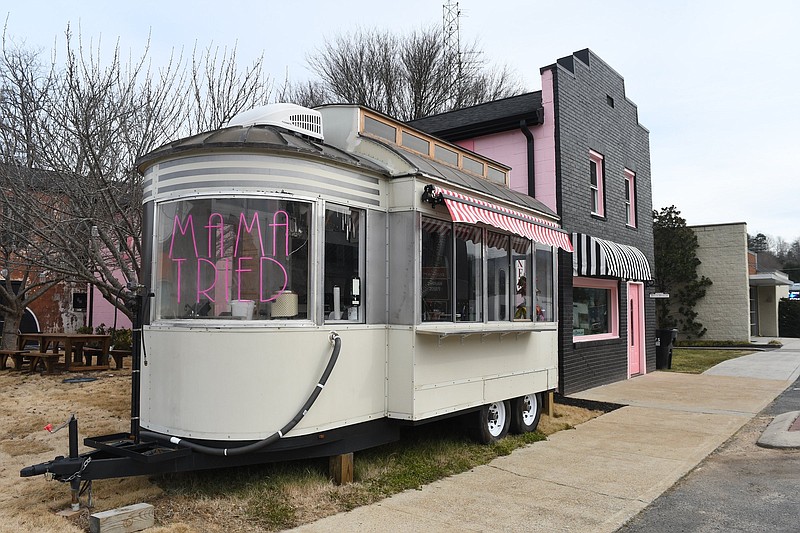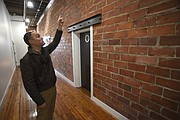As shopping malls went up in sprawling, small-town suburbs, and downtown business districts grew quiet, the buildings sat empty for decades. The soaring ceilings and vast windows, the wide beams of timber, the heavy red brick walls gathered dust.
Sharon Marr, the executive director of MainStreet Cleveland since 2005, watched it happen to her hometown.
"When I was growing up in the '60s and early '70s, everything was downtown," says Marr, a fourth-generation resident of Cleveland, Tennessee. "As malls rose, downtowns lost their vibrancy."
But the tides have turned, Marr says, and the change is taking hold and growing.
"The biggest change has been in downtown housing," Marr says. The MainStreet Cleveland loft apartment tour that began soon after she joined the downtown booster originally featured nine loft apartments, "and we were really excited about that.
"Now we have over 100," Marr says.
More than 30 of them belong to Nicholas Lillios. When he was a child, Lillios would tour the old, empty Ford dealership his great-grandfather had owned in downtown Cleveland, and listen as the patriarch imagined what might be done with the historic building someday.
"As a kid, I'd go up there and he always told me what beautiful apartments this would make," Lillios says. "He had lived in New York City in the '60s and '70s. He knew that potential, and I thought he was nuts.
"I thought, 'Who would want to live downtown?'"
Lillios got his answer when he started dabbling in renovation of a couple of downtown buildings, converting their upper floors to just a handful of apartments in 2010. They quickly filled with a mix of Lee University students, empty-nesters and downtown employees.
"I was sort of testing the waters as I went along," Lillios says.
That success inspired him to convert the old Ford dealership to 14 loft apartments and ground-floor retail, opening the building to tenants in 2012 after extensive renovation.
"I owned it, and had owned it for four generations, so I didn't have to buy it to find out if it was going to work," he says. "As I started taking calls and leasing it up, a lot of folks that worked downtown were interested – restaurant employees and bank tellers, police officers that worked at the station across the street."
In 2020, he opened his most ambitious project – the Agora building, 44,000 square feet that had been a looming, brick manufacturing facility in the heart of the city until it closed down in the 1980s. It had stood all but empty since, and Lillios developed 19 apartments upstairs and retail on the ground floor.
"As more people moved in, we saw more businesses open up," Lillios says. "Residents were really liking the idea of walking out of the apartment and there are people to see and things to do."
Ken and Teresa Cox, empty-nesters with three grown sons, appreciate the ease of loft life in the Agora after years of maintaining homes and yards, they say.
"We love the freedom," Teresa Cox says. "We can just lock it up and leave it."
Their balcony overlooks the park that hosts concerts and markets in the warm months, giving them a front-row seat on the town's activities, she adds.
"We get to see everything," Teresa Cox says.
Rob McGowan and Beth Finnell also live in the Agora, just a block or so from the businesses they own and operate – his Mash and Hops watering hole and her wine bar, The Press.
"I love how it's changing, and how everything is moving towards downtown," McGowan says. He grew up in Cleveland, but moved away to Chattanooga for a time, and would visit his hometown periodically, he says.
"It really hit in the late '80s and early '90s," he says. "I'd come up from Chattanooga and walk around and it was a ghost town."
These are not easy projects, Lillios says, pointing to the complexities and expense of working with the quirks and limitations of old, often derelict structures in the heart of old city centers. But reviving the city is gratifying, and the details of the properties are irresistible, he says. The walls made of old red bricks wider than an adult's hand, the vast windows and wide-planked wood floors, the high ceilings and exposed beams.
"They're special," Lillios says of these salvaged places.
'It can't be replicated'
Thirty miles to the south, in Dalton, Georgia, Lowell Kirkman agrees. When he and his son, Nathan Kirkman, decided to buy an old, abandoned textile mill on the periphery of downtown, "it was a matter of heart over brain," he says with a crooked grin.
"I got word there was a developer looking to tear it down and turn it into storage units and sell the brick and the timber out of it," says Lowell Kirkman, who grew up in Dalton and operates an architecture firm with his son. "I just couldn't let it happen."
The old Crown Mill campus – more than three acres with multiple brick structures – had been empty since the business shuttered in the 1980s, says Nathan Kirkman. But the building materials and the design of the place were remarkable, he adds.
"The architecture and the bones of the facility are phenomenal," says the younger Kirkman. "You can't build them anymore – it can't be replicated. Our premise was, 'Let's show off the good stuff and create a really cool vibe and see what happens.'"
The men put together an investment group and, in 2003, started building 66 apartments in one of the buildings on the campus, completing them in 2005. Rents were a bit higher than is typical in the market, but the gamble paid off, Nathan Kirkman says.
"It was definitely kind of a risk, but we thought there was a niche and that turned out to be correct," he says. "We filled up pretty quickly and brought in a management company that ran it for us. They have 100% occupancy with waiting lists."
Then the men turned their attention to the neighboring, 40,000 square-foot structure that is now The Mill at Crown Garden, a mixed-use market housing an array of retailers, restaurants and events spaces – a design Nathan Kirkman modeled after the urban Ponce City and Krog Street markets in Atlanta, where he lives.
"I live less than a quarter mile from Krog Street," Nathan Kirkman says. "We're taking those same principles and plotting them on a smaller scale."
The pandemic meant The Mill got off to a slow start, but the men used federal aid to cover some expenses and relieve their retail tenants of some financial stress, Nathan Kirkman says.
"We wanted to kind of curate the right mix of tenants, we went after and wanted to promote local businesses, and almost every business in there is a first-time business owner," he says.
The next phase of the project will be another set of apartments, this one geared to shorter-term stays for employees of the booming local flooring industry who need accommodations during repeat or long visits.
The return to these old places is a pendulum swing from his years growing up in Dalton the '70s and '80s, when the heart of downtown had been hollowed out, Nathan Kirkman says.
"I think it's a way of life that people are more drawn to now," he says. "Being in your car, driving from strip center to strip center, I think is not really appealing. People want walkable communities, pedestrian-friendly environments, social interaction."
In city planning, it's called "new urbanism," but it's really a return to an old way of life, Nathan Kirkman says.
"People have always got to break things, and then be like, 'That was dumb, let's try what used to work,'" he says.
The comeback
When Lewie and Becky Card made their way back to her hometown of Dunlap, Tennessee, they went hunting for real estate projects. They didn't have to look far. Working with the Chamber of Commerce to find empty buildings in the old downtown, they identified 17.
"We've ended up with seven of them," Lewie Card says.
The crown jewel of their restoration efforts is the Dunlap Mercantile, which had sat empty for 45 years after a downtown flood.
The Cards had retired to Naples, Florida, but decided to return and invest in the town where Becky was raised, and where she worked for 20 years as a dentist. They bought the old mercantile in 2019, and brought it back to life as a place to buy nearly anything, and to sit and have a soda to catch up with the neighbors.
"This was the mercantile back then," Lewie Card says. "This was the WalMart of its time."
The Cards are just getting started, and their most recent acquisition, the Mansfield House, is a stately white home on a corner lot in the heart of downtown Dunlap. They plan to convert it into a short-term rental for folks hoping to spend time in the mountains, and they've also converted another nearby building into a rental space and music studio.
As people move from across the country to relocate in small towns, the hearts of these little cities need to be healthy, Lewie Card says.
"We're growing, and the people are from California, Chicago, Colorado," he says. "People are moving here because Tennessee is the best. You've got four seasons, mountains, valleys, rivers."
Janis Kyser, executive director of the Sequatchie/Dunlap Chamber of Commerce, grew up in the area, went away for school and work, and then returned decades later to promote the growth of her hometown. As young people get older, many of them want a simpler pace of life, Kyser says.
"Especially the millennials and Gen X," she says. "They get tired of the hustle and bustle and 500 people in line for a COVID test."
Thomas Austin was born in Dunlap, raised on a farm his great-grandfather owned, and is raising his family in the area. He went to Middle Tennessee State University and then to law school in Nashville, but then he was ready to come home.
"I got married in law school, and we did not want to live and raise children in a big city," says Austin, whose children are 4 and 6.
Walking the streets of downtown Dunlap, Lewie Card points to the growing number of properties that have been reclaimed in the center of the small city. Investing in these places is a bet that pays off in growth and in creating a place people want to be – and where young people want to stay, he says.
READ MORE
* Online anywhere: Rural broadband gets a boost from pandemic funds and work-from-home demand
* Made here: Counties around Chattanooga are magnets for manufacturing

